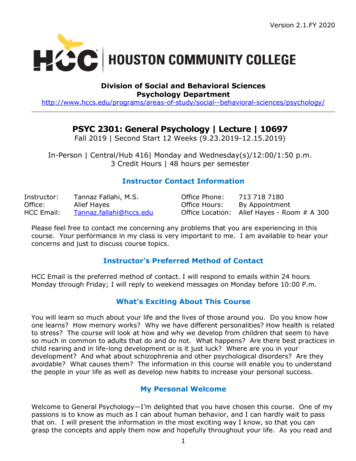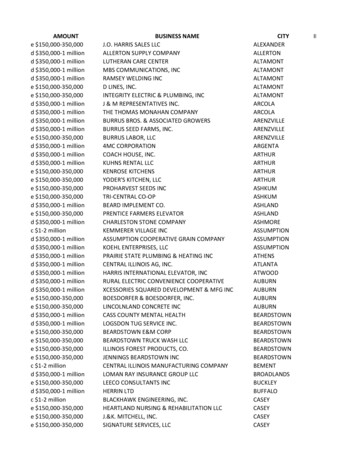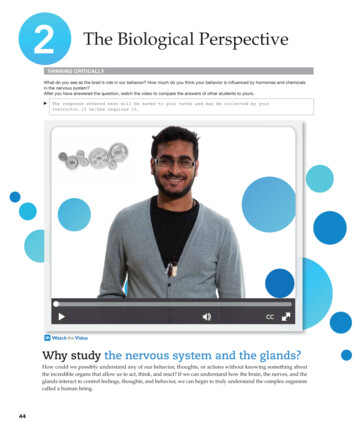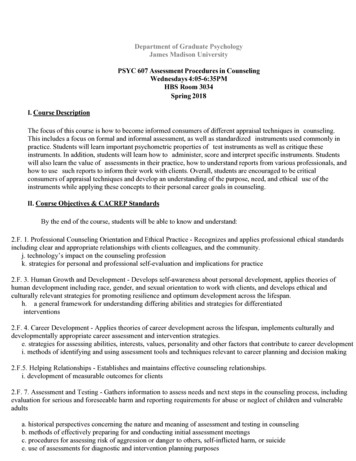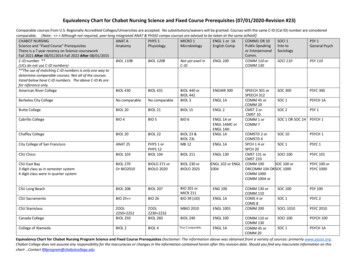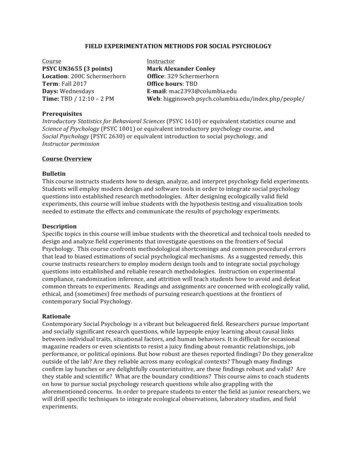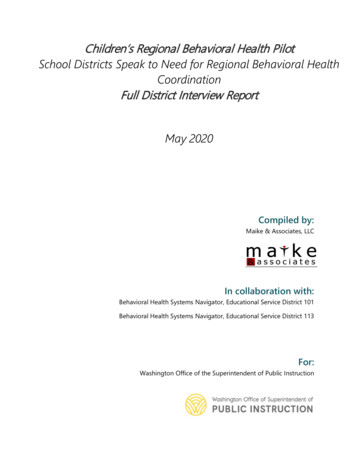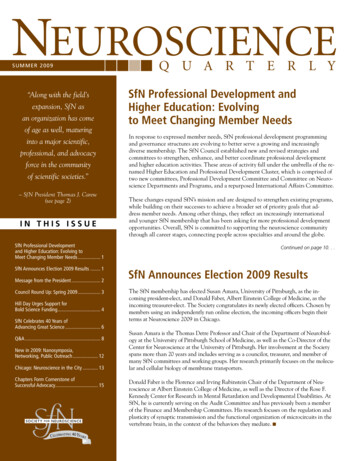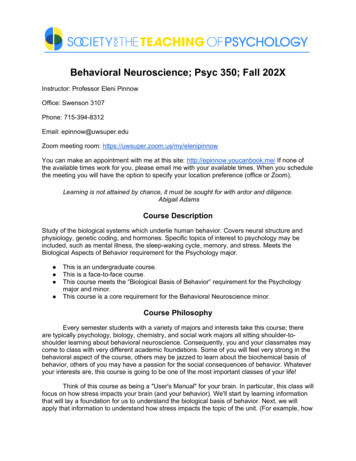
Transcription
Behavioral Neuroscience; Psyc 350; Fall 202XInstructor: Professor Eleni PinnowOffice: Swenson 3107Phone: 715-394-8312Email: epinnow@uwsuper.eduZoom meeting room: https://uwsuper.zoom.us/my/elenipinnowYou can make an appointment with me at this site: http://epinnow.youcanbook.me/ If none ofthe available times work for you, please email me with your available times. When you schedulethe meeting you will have the option to specify your location preference (office or Zoom).Learning is not attained by chance, it must be sought for with ardor and diligence.Abigail AdamsCourse DescriptionStudy of the biological systems which underlie human behavior. Covers neural structure andphysiology, genetic coding, and hormones. Specific topics of interest to psychology may beincluded, such as mental illness, the sleep-waking cycle, memory, and stress. Meets theBiological Aspects of Behavior requirement for the Psychology major. This is an undergraduate course.This is a face-to-face course.This course meets the “Biological Basis of Behavior” requirement for the Psychologymajor and minor.This course is a core requirement for the Behavioral Neuroscience minor.Course PhilosophyEvery semester students with a variety of majors and interests take this course; thereare typically psychology, biology, chemistry, and social work majors all sitting shoulder-toshoulder learning about behavioral neuroscience. Consequently, you and your classmates maycome to class with very different academic foundations. Some of you will feel very strong in thebehavioral aspect of the course, others may be jazzed to learn about the biochemical basis ofbehavior, others of you may have a passion for the social consequences of behavior. Whateveryour interests are, this course is going to be one of the most important classes of your life!Think of this course as being a "User's Manual" for your brain. In particular, this class willfocus on how stress impacts your brain (and your behavior). We'll start by learning informationthat will lay a foundation for us to understand the biological basis of behavior. Next, we willapply that information to understand how stress impacts the topic of the unit. (For example, how
does chronic stress impact development? How does sleep deprivation change our stressresponse? Why is exercise such an effective stress reducer?) At the end of this semester you'llknow both how your nervous system functions optimally--and how stress changes thatfunctionality. Regardless of your future profession, this is something that is incredibly importantto all of us! I have structured this course in a way that will help you recognize the effects ofstress in your own life and, hopefully, find ways to minimize it. As you go out into the world, thisinformation will be invaluable to those you come across in your personal and professional life.I'm excited about our semester together and I hope you will feel a deep sense of awe andgratitude for your amazing brain by the end of our time together.How this course is different (an introduction to C.R.E.A.T.E.)This class will probably be unlike any other class you’ve taken at UW-Superior or in highschool (unless it was a class with me). So, what is C.R.E.A.T.E and why am I doing this?C.R.E.A.T.E. stands for Consider, Read, Elucidate hypotheses, Analyze, Think of the nextExperiment. This is an alternate way for you to learn about Psychology and Science in general.I’ve been teaching Behavioral Neuroscience for nearly 12 years, and I’ve found that traditionalmethods just aren’t effective in engaging students in critical thinking. Perhaps you can relate:you take a class and are just asked to memorize definitions, or formulas or theories but youdon’t really understand what those concepts mean or how they relate to the big picture or howthey can be applied to the “real world.” So, many classes simply test your memory, not youractual comprehension of the topic. Also, lectures are boring (for you and for me). I want to makesure that you are engaged and that you feel in control of your learning.C.R.E.A.T.E. offers a different approach. Instead of being asked to memorize and repeatback answers, you will need to actually understand how ideas relate to each other, how to usethe scientific method and how to think like a scientist. You will certainly learn ideas, terms, andtheories in this class. Simply memorizing the terms, however, will not be enough to succeed.You will need to use this knowledge creatively. The bulk of the C.R.E.A.T.E. methodology refersto how you will read scholarly articles in this class. First, you will read just the introduction of thepaper and connect it to the textbook and lectures; next you will make a concept map that tiestogether all of those main ideas from the article, textbook, and lecture. Next, you’ll read themethod section of the article. You’ll create a brief cartoon (like a comic strip or graphic novel)that shows all of the steps that the researchers took in conducting this study. Don’t worry--yourart skills are not part of the grade (seriously, ask me to draw you a mouse; it is not pretty).Finally, I’ll give you just the figures and tables of the results. You’ll annotate them and markthem up and analyze what results the method yielded. Then, you’ll evaluate the study and thinkabout what would be a good next step! For some of you, this will make you nervous because itis new, different and probably pretty different to how you usually study. I urge you not to bescared and nervous, though. This method will help you understand Psychology more richly. Itwill also help you be a better reader and better thinker. In combination, these skills will help youin your future college career—regardless of your major!University Learning Outcomes (ULO)1. Students will apply modes, styles, and conventions of communication appropriate to thestudents’ work and their audience2. Students will clearly express themselves to achieve a purpose3. Students will articulate important questions, theories, and creative processes4. Students will analyze information to answer specific questions
5. Students will use evidence to reach and present innovative conclusions or produceoriginal workProgram Learning Goals (PLO) & Course Learning Goals1. Students will demonstrate effective skills in written and oral communication throughcritiques of psychological research.2. Students will be able to communicate and critique basic research methods in psychology(specifically behavioral neuroscience), including research design, data analysis, andinterpretations.3. Students will be able to apply behavioral neuroscience to individual, interpersonal,group, and societal issues.4. Students will be able to use critical thinking, skeptical inquiry, and a scientific approachto address issues related to the biological basis of behavior.Textbook (required):Kalat, J. (2015). Biological Psychology, 13th Edition. With Mindtap access code! (Note: if youpurchase the Cengage All Access code for the semester, that is sufficient for what you need inthis class.)GradingMastery Trainings: These assignments are basically adaptive quizzes based on the textbook;you’ll get more questions about topics that you make mistakes on. Mastery Trainings will take avaried amount of time; the earlier in the semester mastery trainings (Chapters 1-4, 11) will takea full week of work before they are completed (later mastery trainings require, on average, 4days). It’s really important to keep up with these. You must start these early--so please planahead!!! Chapter 1, 2, 3: 40 points per chapter; Chapter 4 and 11: 30 points per chapter;all other chapters: 20 points per chapter.Related Learning Outcomes:ULO (University Learning Outcomes): 3, 4PLO (Psychology Learning Outcomes): 2, 3, 4Fair presentations: You will take part in an information fair about a topic in BehavioralNeuroscience. You will work in teams to create a booth and handout that describes yourassigned topic. Each presentation and handout is worth 25 points.Neurotransmitter presentation options: serotonin, dopamine, acetylcholine, glutamate,GABA, norepinephrine, epinephrine, histamine, vasopressin, oxytocinSleep presentation options: light sleep, deep sleep, REM sleep, brain structures involved insleep, neurotransmitters involved in sleep, behavioral and health related to sleep, sleepdisorders, biological theories of dreaming A week before the fair you'll be assigned to a group. Each group will have a topic. The groups will make an information booth and handout fortheir topic. The booths should all include information that goes beyond what is coveredin the textbook or lecture. Enough handouts should be brought to class for all students (you can email me yourhandout and I can print them prior to class). You will evaluate your group members at the end of the fair
Related Learning Outcomes:ULO: 1, 2, 3, 4, 5PLO: 1, 2, 3, 4Paper Critique and Synthesis: For each of the scholarly articles that we will read in class, youwill be responsible for writing up a critique/review of the article at the end of the unit. These are,essentially, your exams over the unit. So, the depth and quality of information that is provided inthe critique is central to earning a good grade. The critique is made up of 4 points; successfulcritiques will also bring in information from the foundational chapters of the textbook (chapters 14, 11). 75 points.1. Identify the research question and hypothesis of this article (10 points)2. Summarize how this article is related to previous knowledge (from chapter, readings,videos, lecture, etc) (25 points)3. Discuss what knowledge this article brings to the field of knowledge (25 points)4. Discuss meaningful modifications that could be made to the study or a future researchquestion that you think would be helpful to further address this paper’s researchquestion. (15 points)Related Learning Outcomes:ULO (University Learning Outcomes): 1, 2, 3, 4, 5PLO (Psychology Learning Outcomes): 1, 2, 3, 4Article prep work: You will submit a screenshot or other type of picture of the work (conceptmaps; cartoons, with variables clearly labeled; and annotations of tables and figures). The goalof these assignments is to guide you through reading the articles; these articles can be difficultto understand and process. These are active reading techniques to help you better learn fromthe information. If you struggle, just do your best--these get easier with practice. Please focuson getting your ideas and understanding down--don't worry about making it pretty! Please viewthese assignments as ways to help you master the course content. I will grade these forcompleteness and accuracy. 10 points per prepwork. (Note: I will drop your lowest 2 prepworkscores)Related Learning Outcomes:ULO (University Learning Outcomes): 1, 2, 3, 4PLO (Psychology Learning Outcomes): 1, 2, 3, 4Final Reflection Paper: The final reflection encourages you to show me that you've masteredthe course content that relates to stress and behavioral neuroscience. A successful reflectionwill discuss the application of the course material to your own life and how your knowledge willshape your future behavior (in both your personal and professional lives). 75 pointsRelated Learning Outcomes:ULO (University Learning Outcomes): 1, 2, 3, 4, 5PLO (Psychology Learning Outcomes): 1, 2, 3, 4A note on gradingAll mastery trainings are linked in the Cengage module in our Canvas course. You willneed to go through Cengage to complete all Mastery Trainings; Cengage will automaticallyupdate your grades and completion into Canvas.For all non-Cengage assignments (prepwork assignments, article critiques/unit exams,and the final reflection), you will submit this work on Canvas. For the prepwork, you can uploada screenshot, phone picture, or a document that contains all of the relevant prepwork. These
assignments are graded for completeness. You can find examples of the three types ofprepwork (concept map, cartoon, and annotations) in the "Prepwork Examples Tab" on the"Home" tab. The article critiques/unit exams and the final reflection will be graded using therubric that is provided in the assignment. Please make sure to review the rubric prior tosubmitting this work. On all non-Cengage assignments I will leave comments and feedback inCanvas. If you ever have questions about my grading (or you can't find the feedback), please,please, please reach out!Final Course Grades: Letter grades will be assigned according to the following scale:A: 93-100%A-: 90-92.999%B : 87-89.999%B: 84-86.999%B-: 80-82.999%C : 77-79.999%C: 73-76.999%C-: 70-72.999%D: 60-69.999%F: 60%These cutoffs are firm. Do not ask me to give you an extra assignment to raise your grade orto round up your grade – it is not fair to have standards and opportunities that vary acrossstudents.Late policyLate work will not be accepted. Each unit in this course is based around a sequence ofassignments that build one on top of each other. To make sure I have enough time to providefeedback that will provide meaningful guidance, I need it to be turned in on time. Further, I findthat late work tends to snowball--students may miss one assignment and then turn it in late. Inworking to complete the late assignment they often miss subsequent assignments and the chainkeeps going! Almost every assignment in this course is relatively low point value--so missingone single, small assignment won't have a big impact on your grade (and I drop your two lowestprep grade scores). It's better to just keep moving forward! All assignments will be turned in onCanvas; due dates are stated on the dropbox. All due dates are in the syllabus and posted onCanvas--please, please, please be mindful of them. If you have any questions--please ask me!What students can expect from me My role for this class is to be a professor, cheerleader, and sounding board.I will return graded work within one week.
I will reply to emails within two business days. Emails that ask questions that can easily be answered in the syllabus (i.e. what isdue on class period X? What is your late policy? What did I miss in class?) willreceive a reply to see the syllabus. Some responses may advise the student to sign up for a meeting with me,because the question is not easily answered in email.I will reply to questions posted on the discussion board within 2 business days.I will have at least 5 hours a week available for student appointments.I will be excited to meet with you and help you craft work that you will be proud of.Attendance and Participation (aka: What I Expect from You)Please make sure that you are checking Canvas at least 5 times a week. This is theprimary way that I will communicate with you, and actively being in our course will help youmake sure you are on track with the content and deadlines. In general, there is a positivecorrelation between Canvas presence and final grade: the more you are on Canvas, the betteryour final grade is likely to be! If you will be absent from the courseroom for more than 3consecutive days, please send me an email or Canvas message that includes your plan for thecoursework that you will miss during your absence.QuestionsIf you have questions, please ask them! You can ask them in our Canvas DiscussionBoard! You can ask them via email! You can make an appointment with me! You can write mea notarized letter (I mean, you could but this may be rather slow. . .)! But please, please, pleaseask! If you feel shy or uncomfortable asking, please think about asking questions as a way ofhelping out your classmates. Someone else in class has your question--so you would be doinga great kindness by asking it so everyone can benefit from the answer. Remember: I want tohelp you learn and grow! Asking questions is a very important part of your learning and growth.Also, you want to get the most out of your tuition dollars, right? Ask away!A note on Credit HoursThis class is worth 3 credit hours. What this means is that you’ll spend 3 hours in theclassroom or lab every week. In addition to the time we spend together, you will be expected tospend at least 2 hours out of class per week per credit hour of class. Typically, you can expectto spend 2-3 hours per class hour on work for class. That means that, outside of class meetingtimes, you should spend 6-9 hours per week completing assignments, reading and generallyworking for my class. Please see Academic Policy 1127: Credit Hour Definition.Classroom EnvironmentThroughout the course, you will be expected to reflect on, and engage in, discussions onclass material sharing your thoughts and even differences of opinion. Disagreeing with ideas,holding alternative views and challenging the status quo are all a part of the higher educationtradition, as they provoke us to re-examine our own thinking. That being said, this will be a safeand welcoming learning environment for students of all races, ethnicities, sexual orientations,gender identities, ages, religions, economic classes and ability statuses. To achieve this, youwill be expected to engage in all classroom activities and assignments in a respectful, inclusiveand culturally appropriate manner. If you aren't sure what that may look like, the American
Psychological Association has a very helpful guide to bias-free language that you can find freehere.Academic HonestyThe goal of the University of Wisconsin-Superior is to provide a quality education to allstudents--part of our community standards involves a strong statement supporting academicintegrity. To learn more about how UWS defines academic integrity (and its evil twin, academicdishonesty) please see Chapter 14. The most important aspect of my job is making sure that mystudents are given every opportunity to learn and master the course content. I see my goals foryour learning as aligned with the community standards and academic integrity. Academicintegrity means that all work turned in for a grade must be original and your own; it also must becreated specifically for this class. For purposes of this course, work submitted previously foranother course is prohibited. Remember, the goal of this class is for you to master the conceptsof Behavioral Neuroscience. Consequently, it’s important that you create work specifically forBehavioral Neuroscience.Diversity and Inclusion at the University of Wisconsin-SuperiorDiversity and inclusion is integral to the educational mission of the University ofWisconsin-Superior. As a community we commit to recognize, include and value inherent worthand dignity of each person; foster tolerance, sensitivity, understanding, mutual respect, andjustice among its members; and encourages each individual to strive to reach their ownpotential. The institution recognizes these experiences are crucial for developing the requisiteskills to thrive as a member of a pluralistic society and as a responsible global citizen.In pursuit of its goal of inclusive excellence, the University actively seeks to attractstudents, faculty, and staff from diverse backgrounds and life experiences, including but are notlimited to: race, ethnicity, sex, gender identity, gender expression, sexual orientation, age,socio-economic background, cognitive ability, physical ability, religion and spirituality, valuesystem, national origin, immigration or refugee status, veteran status, and political beliefs.The University believes that diversity among its members strengthens the institution,stimulates creativity, promotes the exchange of ideas, and enriches campus life. The Universityof Wisconsin-Superior views, evaluates, and treats all person in any University related activity orcircumstance in which they may be involved, solely as individuals.Throughout the course, you will be expected to reflect on, and engage in, discussions onclass material sharing your thoughts and even differences of opinion. Disagreeing with ideas,holding alternative views and challenging the status quo are all a part of the higher educationtradition, as they provoke us to re-examine our own thinking. That being said, this WILL be asafe and welcoming learning environment for students of all races, ethnicities, sexualorientations, gender identities, ages, religions, economic classes and ability statuses. Toachieve this, you will be expected to engage in all classroom activities and assignments in arespectful, inclusive and culturally appropriate manner.For more information about Equity, Diversity and Inclusion and/or to report bias,discrimination or harassment, please email edi@uwsuper.edu or call 715-394-8015.Policies and practices to help your learning and growth
The University of Wisconsin-Superior is dedicated to a safe, supportive andnondiscriminatory learning environment. It is the responsibility of all undergraduate andgraduate students to familiarize themselves with University policies regarding specialaccommodations, academic misconduct, religious beliefs accommodation, discrimination andabsence for University- sponsored events.Please review the Student Information Sheet provided by your instructor. This includespolicies related to: Student characteristics, including policies and services related to those who are activemilitary/veterans, those who are pregnant or expecting new family members, andstudents seeking services for differing abilities and accommodations student services,and others. Academic integrity, including information on plagiarism and steps that an instructor cantake. Campus policies, including how to sign up for Safe Alerts, information on courseevaluations, process for submitting a formal grievance regarding academics and/ordiscrimination, and others.Disability and accommodationsAll of the materials on Canvas have been designed to be read using a screen reader;your textbook also has an audio option. I have tried to be mindful of anticipating any issues thatmay come up regarding the accessibility of the course materials. This is an area where Iwelcome feedback and hope to grow. Please let me know if you experience any issues with theaccessibility of the course materials and I will find a solution!If you need accommodations, please contact Disability Support services disability@uwsuper.edu . You can find their office in Swenson 1024A or you can call them at715-394-8188. You also can request services using the online “Accommodate System.” Once Ireceive a copy of your accommodations, we will make sure you have all the tools that you needto succeed!Mental HealthOn average, one in five Americans will experience mental illness in any given year.Worse, 60% of Americans will not seek treatment for their illness. Mental illness can bedebilitating—but it is treatable. If you are struggling with mental health issues, please seektreatment. If you know someone who is struggling with mental health issues, please urge themto get help. Below are some resources that may be helpful for you (or anyone else strugglingwith mental health).UW-Superior Counseling Service715-394-8236Minnesota Crisis Line800-634-8775Wisconsin Crisis Line715-395-2259MWC 1729
National Suicide Prevention Lifeline 800-273-8255Amberwing Crisis Line218-723-0099LBGTQ Crisis Line866-488-7386Veterans Crisis Line800-273-8255 (press 1)Depression Toolkithttp://www.depressiontoolkit.orgTexting hotlineText “ANSWER” to 839863Tentative ScheduleWeekReadingsAssignmentsWeek 1Chapter 1: Nerve Cells and NerveImpulsesChapter 1 Mastery TrainingWeek 2Chapter 2: Synapses andNeurotransmittersChapter 2 Mastery Training;Neurotransmitter FairWeek 3Chapter 3: Anatomy and ResearchMethodsChapter 3 Mastery TrainingWeek 4Chapter 4: Genetics, Evolution,Development, PlasticityChapter 4 Mastery TrainingChapter 11 Mastery TrainingChapter 11: Emotions, Aggression, andStressWeek 5Stress paper: Intro, Method, Figure 1CMap Stress Intro, Cartoon Stress Method,Annotate Stress Paper Figure 1
Week 6Stress paper: Figures 2 and 3Annotate Stress Paper Figures 2 and 3;Stress Paper Critique and SynthesisWeek 7Stress recovery paper: Intro, Method,FiguresStress Recovery CMap, Stress RecoveryCartoon, and Stress Recovery AnnotationsWeek 8Chapter 8: Wakefulness and SleepRecovery Paper Critique and Synthesis;Chapter 8 Mastery Training; Sleep FairWeek 9Sleep Paper Intro, Method, FigureSleep CMap and Sleep Cartoon and SleepPaper AnnotationsWeek10Chapter 12: Learning and MemorySleep Paper Critique and Synthesis;Chapter 12 Mastery TrainingWeek11Chapter 13: Cognitive Functions;Alzheimer's Disease (AZD) Paper Intro;AZD MethodChapter 13 Mastery Training and AZDCMap and CartoonWeek12AZD FiguresAZD Annotations; AZD Paper Critique andSynthesisWeek13Chapter 14: Psychological Disorders;Depression Paper Intro and MethodChapter 14 Mastery Training; DepressionPaper CMap & CartoonWeek14Depression paper Method and FiguresDepression Figures; Depression PaperCritique and Synthesis
Week15Allostatic Load and race paper Intro,Method, and FigureAllostatic load and race CMap, Cartoon,and Annotation; Final Reflection
Appendix AStress PaperEiland, L., Ramroop, J., Hill, M., Manley, J., & McEwen, B. (2012). Chronic juvenile stressproduces corticolimbic dendritic architectural remodeling and modulates emotional behavior inmale and female rats. Psychoneuroendocrinology, 37, 39-47.Stress Recovery PaperSchoenfeld, T., Rada, P., Pieruzzini, P., Hsueh, B., & Gould, E. (2013). Physical exerciseprevents stress-induced activation of granule neurons and enhances local inhibitorymechanisms in the dentate gyrus. The Journal of Neuroscience, 33, 7770-7777.Sleep PaperMinkel, J., Moreta, M., Muto, J., Htaik, O., Jones, C., Basner, M., & Dinges, D. (2014). Sleepdeprivation potentiates HPA axis stress reactivity in healthy adults. Health Psychology, 33,1430-1434.Alzheimer’s Disease paperBaglietto-Vargas, D., Chen, Y., Suh, D., Ager, R., Rodriguez-Ortiz, C., Medeiros, R., Myczek,K., Green, K., Baram, T., & LaFerla, F. (2015). Short-term modern life-like stress exacerbatesAB-pathology and synapse loss in 3xTg-AD mice. Journal of Neurochemistry, 134, 915-926.Depression paperCaspi, A., Sugden, K., Moffitt, T., Taylor, A., Craig, I., Harrington, H., McClay, J., Mill, J., Martin,J., Braithwaite, A., & Poutlon, R. (2012). Influence of life stress on depression: Moderation by apolymorphism in the 5-HTT gene. Science, 301, 386-389.Race and allostatic load paperDuru, O., Harawa, N., Kermah, D., Norris, K. (2012). Allostatic load burden and racial disparitiesin mortality. Journal of the National Medical Association, 104, 89-95.
Appendix BConcept Map Pull out all of the keywords/concepts/vocabulary from the article that you think isimportantInclude related vocabulary from the textbookCreate an interconnected web with the concepts being connected by lines that arenamed and describe the nature of the connection between the concepts.This might get messy--let it get messy!
Cartoon Think of this as a mini-graphic novel or a comic strip.You are creating a cartoon that describes all of the steps that the researchers took in thispaper.From the cartoon, it should be clear what the researchers did, who the participants were,and what the variables were.Remember, this isn't an art class! Don't worry about making this look pretty or beautiful.
Annotations Skip the actual statistics that are written out in the text.Instead, go through the tables and figures that are in the document. Mark them up!Label the y-axis, x-axis, variables, columns, rows, etc.Include the research question that each figure is asking.Briefly (1-2 sentences) summarize what these results say about the research questionand why they are important.
Appendix CPaper Critique and Synthesis RubricCriteriaExcellentSatisfactoryPoorIdentify researchquestion andhypothesis10 to 8.5 ptsExcellentResearch question(s)and hypothesis(es) arecorrectly identified.They are phrasedclearly and accurately;they are in the student’swords.8.5 to 6.5 ptsSatisfactoryResearch question(s)and hypothesis(es) aremostly correctlyidentified. There maybe minor omissions or alack of clarity.6.5 to 0 ptsPoorDoes not meet therequirements forExcellent orSatisfactory.Connection toprevious knowledge25 to 20.5 ptsExcellentThere is a cleardemonstration ofmastery of the coursecontent. The learnerclearly connects thepaper to material in theclass (chapters, lecture,other papers, videos,etc). The connectionshows mastery andapplication of the othercourse content and thepaper. There is anintegration of the paperand previous contentthat is deep and showsthat both areunderstood at a levelthat is appropriate foran upper-division class.20.5 to 16.5 ptsSatisfactoryThere is a cleardemonstration ofunderstanding of thecourse content. Thelearner clearly connectsthe paper to material inthe class (chapters,lecture, other papers,videos, etc). Theconnection shows anunderstanding of theother course contentand the paper. There isan integration of thepaper and previouscontent that shows thatboth are understood ata level that isappropriate for anupper-division class.16.5 to 0 ptsPoorDoes not meet therequirements forExcellent orSatisfactory.New knowledge25 to 20.5 ptsExcellentThere is a cleardemonstration ofmastery of the coursecontent. The studentexplains the resultswithin the context of theresearch question andhypothesis. Thediscussion of the resultsplaces them within thecontext of previousknowledge and appliesthem to meaningfullyshow the contribution of20.5 to 16.5 ptsSatisfactoryThere is a cleardemonstration ofunderstanding of thecourse content. Thestudent explains theresults within thecontext of the researchquestion andhypothesis. Thediscussion of the resultsplaces them within thecontext of previousknowledge and appliesthem to meaningfully16.5 to 0 ptsPoorDoes not meet therequirements forExcellent orSatisfactory.
Modification andfuture researchthe article to the field.show the contribution ofthe article to the field.There may be vagueinformation or a lack ofdepth in the explanation15 t
Study of the biological systems which underlie human behavior. Covers neural structure and physiology, genetic coding, and hormones. Specific topics of interest to psychology may be included, such as mental illness, the sleep-waking cycle, memory, and stress. Meets the Biological Aspects of Behavior
